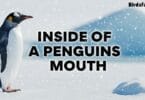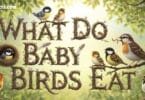
Smallest-Birds-in-Michigan
Have You Ever Paused At Your Window Trying To Catch A Glimpse Of A Tiny Bird Darting Through The Trees. Sometimes It Feels Impossible To Tell Which Feathered Friend Just Zipped By It’s So Small You Wonder If You Imagined It. That’s The Fun And Sometimes Frustrating Part Of Birdwatching In Michigan Spotting The Smallest Birds in Michigan Can Feel Like Solving A Delightful Little Mystery.
If You’ve Ever Wanted To Know Which Of These Tiny Species Are Filling Your Backyard With Chirps And Songs You’re In The Right Place. This Guide To The Smallest Birds in Michigan Will Help You Identify Them More Easily Learn Their Habits And Maybe Even Attract Them Closer To Your Feeders. Let’s Dive Into The Fascinating World Of Michigan’s Tiniest Songbirds.
American Goldfinch

American Goldfinch with bright yellow body and black wings perched on a branch
The American Goldfinch Is One Of The Most Recognizable Backyard Birds Of Michigan Thanks To Its Bright Yellow Plumage In Summer. Males Wear Striking Golden Feathers With Bold Black Caps While Females Remain More Subdued In Olive Tones. During Winter Both Sexes Molt Into Duller Shades Making Them Blend With The Muted Landscape These Tiny Birds Are Among The Smallest Birds in Michigan Often Seen In Flocks Feeding On Sunflower And Thistle Seeds In Fields And Backyards.
This Small Songbird Is A True Seasonal Specialist. Unlike Many Birds That Nest Early In Spring Goldfinches Wait Until Midsummer When Seeds Are Plentiful. Their Cheerful “po-ta-to-chip” Flight Call Is Easy To Identify During Hikes Or While Watching Them Dart Between Wildflowers. If You Set Up A Thistle Feeder You’ll Likely See These Feathered Gems Clinging And Feeding In Acrobatic Poses Making Them One Of The Most Delightful Smallest Birds in Michigan To Observe.
| Fact | Details |
|---|---|
| Size | 4.3 – 5.1 Inches |
| Diet | Seeds (especially Thistle And Sunflower) |
| Habitat | Fields Meadows Suburban Backyards |
| Call | Distinct “po Ta To Chip” Flight Song |
| Fun Fact | Breeds Later Than Most Michigan Songbirds |
Black-capped Chickadee

Black-capped Chickadee with black cap and bib, white cheeks, and gray wings perched on a branch
The Black Capped Chickadee Is A Year Round Resident In Michigan And One Of The Most Beloved Backyard Birds. Small But Bold This Species Weighs Less Than Half An Ounce Yet Shows No Fear Of Humans. Its Trademark “chick-a-dee-dee” Call Is Often The Soundtrack Of Winter Birdwatching Trips. With A Black Cap Bib And White Cheeks These Tiny Birds Are Instantly Recognizable As They Hop Between Branches. Smallest Birds in Michigan Like The Black Capped Chickadee Bring Cheer To Even The Coldest Days.
Chickadees Are Also Clever Food Cachers Storing Seeds In Hidden Spots To Survive Harsh Winters. At Feeders They’re Often The First To Arrive And Last To Leave Sometimes Grabbing A Single Sunflower Seed And Flying Off To Crack It Open Elsewhere. Their Play ful Antics Like Hanging Upside Down To Forage Make Them Favorites Among Bird Enthusiasts Across The Great Lakes. Smallest Birds in Michigan Such As These Prove That Tiny Wings Can Carry Enormous Spirit.
| Fact | Details |
|---|---|
| Size | 4.7 – 5.9 Inches |
| Diet | Seeds Insects Berries |
| Habitat | Woodlands Backyards Parks |
| Call | Famous “chick a dee dee” song |
| Fun Fact | Can Lower Body Temperature At Night To Conserve Energy |
Blue-gray Gnatcatcher
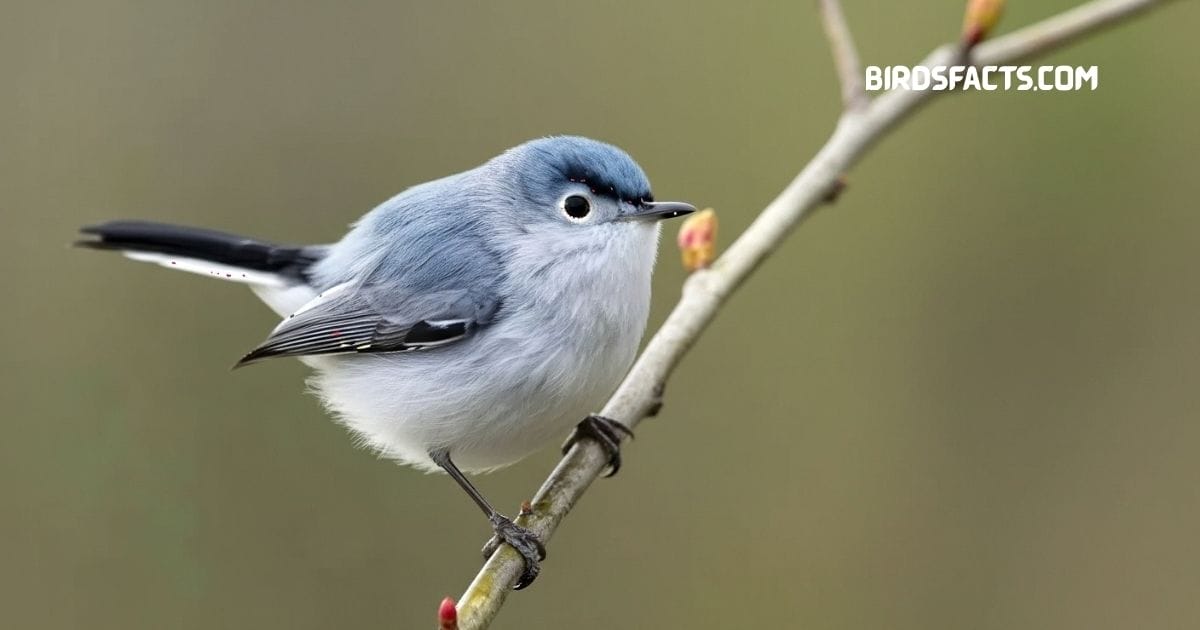
Blue-gray Gnatcatcher with slender body and long tail perched on a branch
The Blue Gray Gnatcatcher Is One Of The Smallest Birds in Michigan Weighing Less Than A Quarter Of An Ounce With A Slender Build And Long Tail It Flits Restlessly Through Tree Canopies Searching For Insects. Its Pale Blue Gray Plumage And Thin White Eye Ring Make It Look Almost Delicate Yet This Bird Is A Relentless Hunter Of Gnats Flies And Tiny Caterpillars.
In Michigan Gnatcatchers Arrive In Spring And Can Be Found In Deciduous Forests Often Near Streams. Their High Pitched Calls And Constant Tail Flicking Help Birdwatchers Spot Them Despite Their Tiny Size. They Build Remarkable Cup Shaped Nests Camouflaged With Lichens Blending Perfectly With Branches. Watching A Pair Feed And Defend Their Territory Is One Of The Joys Of Spring Birding In The State Making Them One Of The Most Charming Smallest Birds in Michigan To Observe.
| Fact | Details |
|---|---|
| Size | 4 – 4.3 inches |
| Diet | Insects Spiders Gnats |
| Habitat | Deciduous Forests Woodland Edges |
| Call | Thin High pitched “spee” Notes |
| Fun Fact | Builds Nests That Mimic Tree Bark With Lichen |
Black-throated Green Warbler

Black-throated Green Warbler with yellow face and black throat perched on a branch
This Colorful Warbler Is A Delightful Sight During Spring And Fall Migration Through Michigan. Males Have A Striking Yellow Face With A Black Throat And Olive Green Back While Females Show More Muted Tones. Although They Breed Further North Birders In Michigan Eagerly Await Their Seasonal Stopovers. Smallest Birds in Michigan Like This Warbler Add Splashes Of Color To Forests Each Year With Their Buzzy “zee-zee-zee-zoo-zee” Song.
Spotting The Black Throated Green Warbler Often Requires Patience As They Forage High In The Canopy They Specialize In Eating Caterpillars And Other Insects Making Them Vital For Pest Control During Migration Season. Forest Bird Watchers Often Consider Them Among The Most Exciting Smallest Birds in Michigan To Observe During The Spring Rush When Dozens May Appear At Once.
| Fact | Details |
|---|---|
| Size | 4.3 – 5.1 Inches |
| Diet | Insects (Especially Caterpillars) |
| Habitat | Forest Canopies Migration Stopovers |
| Song | Buzzy “zee zee zee zoo zee” |
| Fun Fact | Often Mixes With Other Warblers In Migration Flocks |
Boreal Chickadee

Boreal Chickadee with brown cap and gray wings perched on a branch
Unlike Its Cousin The Black Capped Chickadee The Boreal Chickadee Is Far Less Common In Michigan. This Species Is Usually Found In The Upper Peninsula’s Dense Coniferous Forests. With Its Brown Cap Grayish Body And Rufous Flanks It Blends Well Into Spruce And Fir Trees. Birders Often Travel North Just For A Chance To Hear Its Scratchy “chick-a-dee” Variation Making It One Of The Most Elusive Smallest Birds in Michigan.
The Boreal Chickadee Is Considered A Rare Treat For Michigan Birdwatchers Because It Barely Enters The State Except In Northernmost Regions. It Is Adapted To Cold Climates And Thrives In Boreal Forests Stretching Into Canada. While Shy Compared To The Bold Black Capped Chickadee Spotting One Of These Secretive Smallest Birds in Michigan Is A Special Experience For Any Dedicated Birder.
| Fact | Details |
|---|---|
| Size | 4.7 – 5.5 Inches |
| Diet | Insects Seeds Berries |
| Habitat | Boreal Coniferous Forests |
| Call | Hoarse “chick A Dee” Notes |
| Fun Fact | Prefers Colder Climates And Rarely Visits Feeders |
Brown Creeper

Brown Creeper with mottled brown feathers climbing up a tree trunk
The Brown Creeper Is A Tiny Woodland Bird That Looks Almost Invisible Against Tree Bark. With Streaked Brown Plumage And A Slender Down Curved Bill It Climbs Upward In A Spiral As It Searches For Insects Hiding In Cracks. Birders Often Describe Spotting This Species As Seeing A “moving Piece Of Bark” Since It Blends In So Well With Its Surroundings. In Michigan These Birds Are Found Year Round In Mature Forests Particularly Where Tall Oaks Maples Or Pines Dominate.
Brown Creepers Are Considered Among The Smallest Birds in Michigan Weighing Less Than A Third Of An Ounce. Their High Pitched Calls Can Be Difficult For Some Ears To Detect But Their Foraging Behavior Is Distinctive Once You Know To Look. Unlike Nuthatches Which Climb Downward Creepers Always Move Upward Giving Them A Unique Feeding Niche. For Patient Birdwatchers Spotting One Of The Smallest Birds in Michigan Can Feel Like Solving A Hidden Puzzle In The Forest.
| Fact | Details |
|---|---|
| Size | 4.7 – 5.5 Inches |
| Diet | Insects Larvae Spiders |
| Habitat | Mature Forests With Tall Trees |
| Call | Thin High pitched Whistles |
| Fun Fact | Builds Nests Behind Loose Bark |
Carolina Wren

Carolina Wren with reddish-brown plumage and white eyebrow stripe perched on a branch
The Carolina Wren Is A Small But Loud Songbird That Has Expanded Its Range Into Michigan Over The Past Century. Recognizable By Its Rich Reddish Brown Plumage And Bold White Eyebrow Stripe This Bird Is Surprisingly Energetic. Its Rolling “tea-kettle Tea-kettle Tea-kettle” Song Can Be Heard Echoing Through Woodlands And Backyards Even In Colder Months. Wrens Are Known For Their Curious And Active Behavior Often Exploring Brush Piles And Woodpiles For Insects.
While Wrens Are Tiny They Belong Among The Smallest Birds in Michigan Yet Their Voices Are Among The Loudest Of All Backyard Species. They Are Year Round Residents In Southern Parts Of The State Though Harsh Winters Can Reduce Their Numbers. Carolina Wrens Often Nest In Unusual Places Including Hanging Baskets Mailboxes Or Sheds. Their Adapt Ability And Strong Presence Make Them One Of The Most Charismatic Smallest Birds in Michigan To Attract To Your Yard.
| Fact | Details |
|---|---|
| Size | 4.7 – 5.5 Inches |
| Diet | Insects Spiders Fruit |
| Habitat | Brushy Woods Backyards Gardens |
| Song | Rolling “tea Kettle Tea Kettle” |
| Fun Fact | Known For Nesting In Odd Spots Around Homes |
Chipping Sparrow
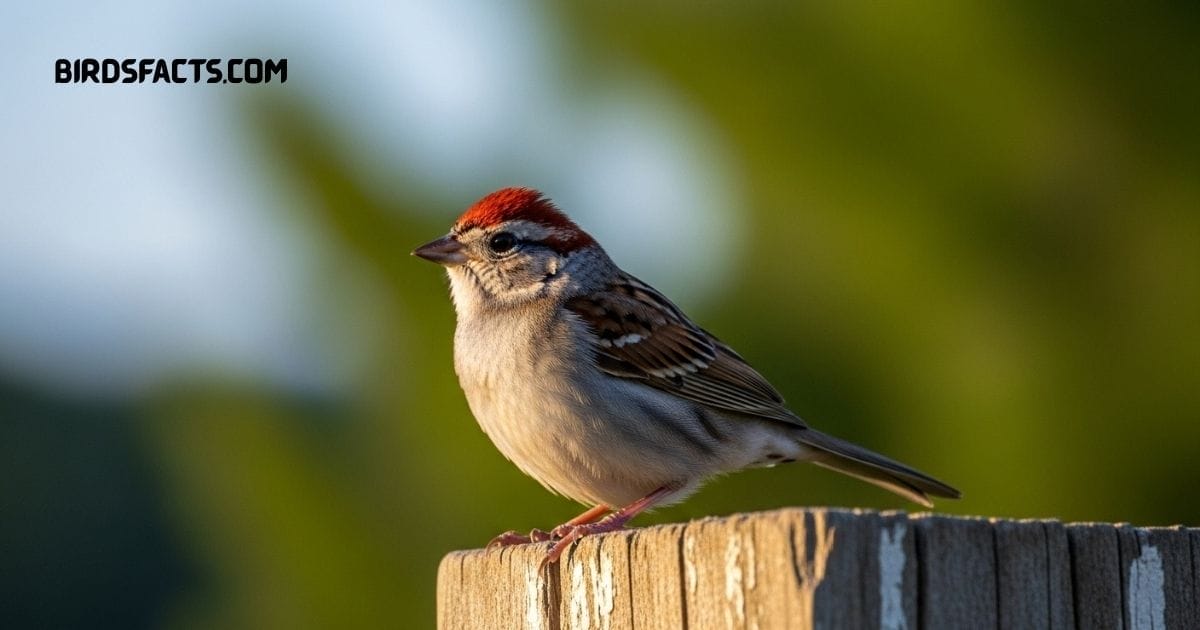
Chipping Sparrow with rusty crown and gray underside perched on a branch
The Chipping Sparrow Is A Common Summer Visitor And An Easy To Identify Bird Across Michigan. With A Bright Rufous Cap Gray Underparts And Black Eye Line It’s A Neat And Tidy Looking Sparrow. These Small Songbirds Are Frequently Found In Open Habitats Like Grassy Yards Parks And Woodland Edges. Their Dry Trilling Song Is A Familiar Sound Of Summer Mornings That Makes Them One Of The Most Recognizable Smallest Birds in Michigan.
Despite Their Delicate Appearance Chipping Sparrows Are Highly Adaptable And Often Forage In Flocks. They Feed On Grass Seeds Grains And Insects Making Them A Useful Species For Keeping Insect Populations Balanced. In Fall They Migrate South But May Linger Longer In Warmer Years. Watching These Cheerful Smallest Birds in Michigan Hop Across Your Lawn Or Gather At Feeders Is One Of The Quiet Pleasures Of Backyard Bird Watching.
| Fact | Details |
|---|---|
| Size | 4.7 – 5.9 Inches |
| Diet | Seeds Insects Grains |
| Habitat | Open Fields Lawns Woodland Edges |
| Song | Dry Steady Trill |
| Fun Fact | Nests In Shrubs Or Small Trees Often Near Homes |
Common Yellowthroat
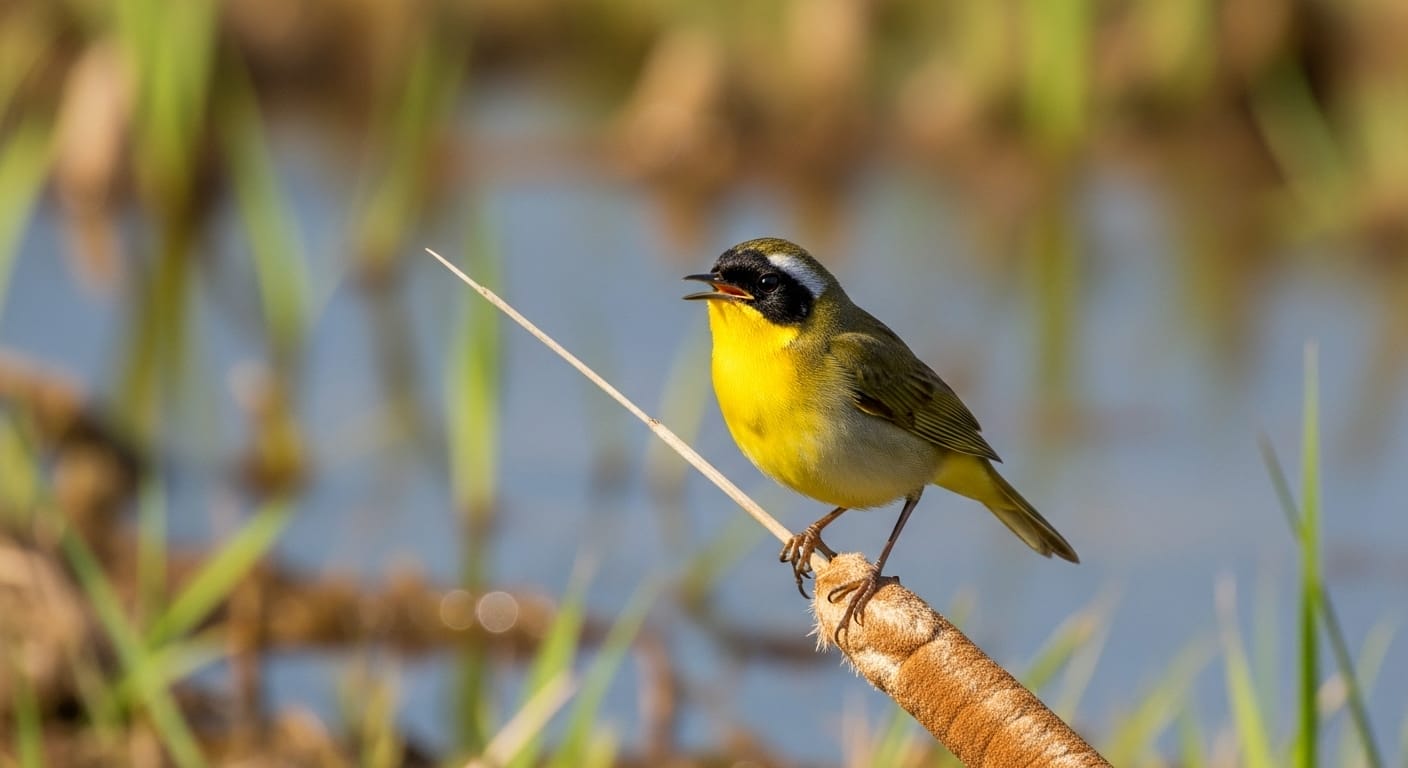
Common Yellowthroat with bright yellow throat and olive-green back perched on a branch
The Common Yellowthroat Is A Striking Little Warbler That Thrives In Michigan’s Wetlands And Marshy Areas. Males Wear A Black Bandit Mask Across Their Faces Set Against Bright Yellow Throats And Olive Backs. Females Are Less Flashy With Plain Olive Plumage And Softer Yellow Underparts. Their Lively “wichity-wichity-wichity” Song Is A Signature Sound In Cattail Marshes During Spring And Summer.
Among The Smallest Birds in Michigan The Yellowthroat Brings A Big Burst Of Energy To Every Birding Trip. It Is A Ground Foraging Warbler Hopping Low Through Vegetation In Search Of Insects And Spiders. Its Adaptability Allows It To Thrive In Wetlands Shrubby Areas And Even Roadside Ditches. Spotting One Of These Smallest Birds in Michigan Pop Up From Tall Grass To Sing Is Always A Rewarding Moment.
| Fact | Details |
|---|---|
| Size | 4.3 – 5.1 Inches |
| Diet | Insects Spiders Small Invertebrates |
| Habitat | Marshes Wetlands Shrubby Edges |
| Song | “wichity Wichity Wichity” |
| Fun Fact | Males Defend Territories With Both Song And Chasing Flights |
Common Grackle
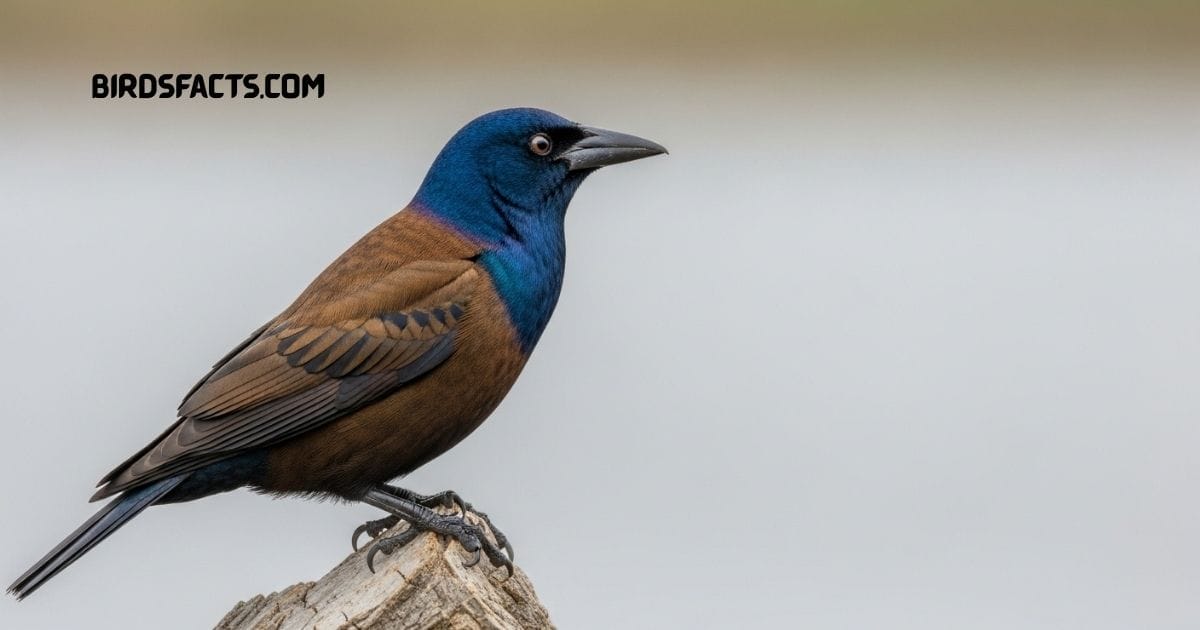
Common Grackle with glossy black plumage and bright yellow eyes perched on a branch
Although Larger Than Many Songbirds The Common Grackle Sometimes Gets Included In Michigan Bird Lists Because Of Its Abundance And Striking Features. With Iridescent Purple Blue Heads And Glossy Black Bodies They Shimmer In The Sun. These Birds Are Loud Social And Often Found In Flocks That Can Number In The Hundreds. Their Creaking Metallic Calls Add To Their Dramatic Presence.
While Not The Tiniest Species Grackles Still Share Habitats With The Smallest Birds in Michigan Often Competing For Feeder Space. They Are Opportunistic Feeders Consuming Seeds Insects Grains And Even Small Animals. In Agricultural Areas They Can Be Seen Striding Through Fields In Search Of Food. Despite Their Reputation As Bully Birds At Feeders Their Intelligence And Glossy Beauty Make Them Worth Appreciating Among The Smallest Birds in Michigan And Their Larger Companions.
| Fact | Details |
|---|---|
| Size | 11 – 13 Inches (larger Than True “tiny Birds”) |
| Diet | Omnivorous Seeds Insects Small Animals |
| Habitat | Fields Backyards Wetlands |
| Call | Harsh Metallic Squeaks And Creaks |
| Fun Fact | Known To Mob Predators In Groups |
Cerulean Warblers

Cerulean Warbler with sky-blue back and white underside perched on a branch
The Cerulean Warbler Is One Of The Most Dazzling Migratory Birds To Pass Through Michigan. Males Wear Sky Blue Plumage With A White Underside While Females Show A Softer Bluish Green. Sadly This Species Is Considered Endangered Due To Habitat Loss Making Every Sighting In Michigan A Special Event. Birders Often Look For Them During Spring Migration As They Stop Briefly In Forest Canopies Before Continuing North.
Among The Smallest Birds in Michigan This Warbler Captures Attention With Its Bright Colors And High Perch Preference. Spotting One Requires Patience And A Good Ear As They Prefer The Highest Branches Of Tall Deciduous Trees. The Presence Of These Smallest Birds in Michigan Highlights The Importance Of Conserving Forest Habitats In The Great Lakes Region Ensuring Future Generations Can Continue To Admire This Tiny Jewel.
| Fact | Details |
|---|---|
| Size | 4.3 Inches |
| Diet | Insects Spiders |
| Habitat | Tall Deciduous Forests During Migration |
| Song | Buzzy Rising Trill |
| Fun Fact | Declining Rapidly Due To Deforestation In Wintering Grounds |
Dark-eyed Junco
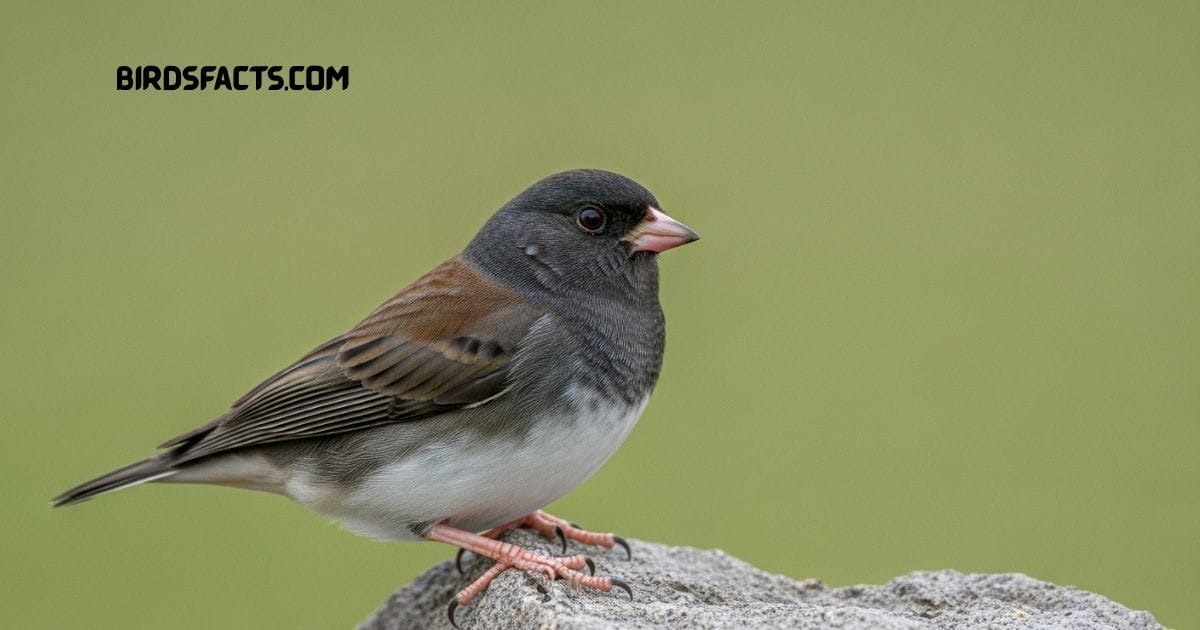
Dark-eyed Junco with slate-gray body and white belly perched on a branch
The Dark Eyed Junco Is One Of The Most Familiar Winter Backyard Birds In Michigan. These Small Sparrows Are Often Called Snowbirds Because They Arrive As Cold Weather Sets In. With Slate Gray Bodies And White Bellies They Stand Out Against Snowy Landscapes. They Forage In Flocks On The Ground Hopping Around Feeders Or Scratching For Seeds Beneath Shrubs.
Despite Their Delicate Look Juncos Are Hardy Birds Adapted To Survive Michigan’s Harsh Winters. Their Simple Tseep Tseep Call And Fluttering Flight Patterns Make Them Easy To Recognize. Many Birders Enjoy Watching Them Return Each Year As Part Of Seasonal Cycles Bringing Life To Otherwise Quiet Backyards. They’re A Perfect Reminder Of How Resilient The Smallest Birds in Michigan Can Be And Why Observing These Smallest Birds in Michigan Adds Joy To Every Winter Day.
| Fact | Details |
|---|---|
| Size | 5.1 – 6.9 Inches |
| Diet | Seeds Insects (during Breeding Season) |
| Habitat | Wooded Edges Backyards Snowy Fields |
| Call | Simple “tseep” Notes |
| Fun Fact | Different Reg |
Evening Grosbeak

Evening Grosbeak with yellow body and black wings perched on a branch
The Evening Grosbeak Is A Striking Finch That Occasionally Visits Michigan Especially During Irruption Years When Food Is Scarce In Canada. Males Have Bold Yellow And Black Plumage With Massive Pale Bills While Females Are Grayish With Yellow Highlights. Despite Being Larger Than Most Tiny Birds They Often Appear Alongside The Smallest Birds in Michigan Creating A Beautiful Contrast At Feeders Across The State.
Evening Grosbeaks Often Arrive In Flocks Sometimes Overwhelming Feeders With Their Appetite For Sunflower Seeds. Their Powerful Bills Allow Them To Crack Even The Hardest Seeds. Spotting Them Is Always Memorable As They’re Not Consistent Residents But Rather Nomadic Wanderers. When They Appear In Winter They Remind Birders How Even Among The Smallest Birds in Michigan There Are Occasional Visitors That Steal The Spotlight.
| Fact | Details |
|---|---|
| Size | 6.3 – 8.3 Inches |
| Diet | Seeds Buds Insects |
| Habitat | Coniferous Forests Occasional Backyard Feeders |
| Call | Sharp “cheer” Notes |
| Fun Fact | Populations Have Declined Steeply Since The 1980s |
Eastern Phoebe
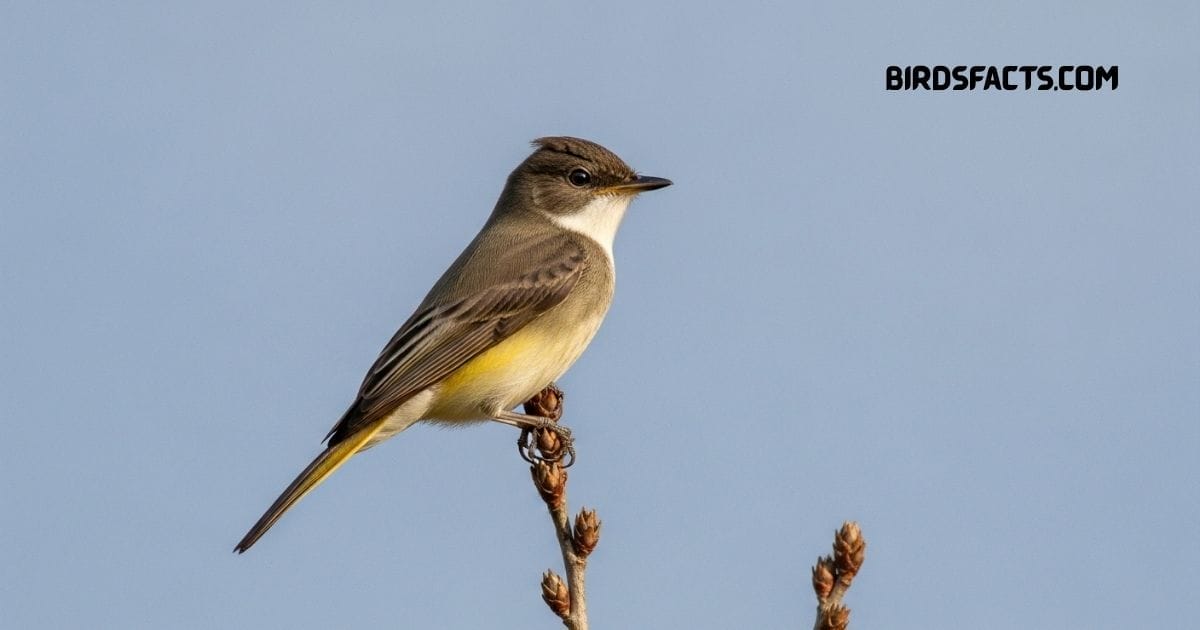
Eastern Phoebe with gray-brown plumage and pale belly perched on a branch
The Eastern Phoebe Is One Of The Earliest Migratory Birds To Return To Michigan Each Spring. This Small Flycatcher Has A Plain Brownish Gray Body White Underparts And A Habit Of Wagging Its Tail While Perched. Its Raspy Fee Bee Call Is A Sure Sign That Warmer Days Are Coming. Birders Often Notice Them Nesting Under Bridges Eaves Or In Barns.
Though Not Among The Smallest Birds in Michigan The Phoebe Shares Habitats With Many Tiny Songbirds And Plays An Important Role In Balancing Insect Populations. Phoebes Feed Mainly On Flying Insects Making Them Valuable Pest Controllers During The Summer Months. They Often Return To The Same Nesting Spot Year After Year Showing Strong Site Fidelity. Watching One Sally Out From A Perch To Snap Up A Fly Is A Classic Sight On Michigan Farms And Fields Reminding Birders That Even Beyond The Smallest Birds in Michigan Every Feathered Visitor Adds To The Beauty Of Spring.
| Fact | Details |
|---|---|
| Size | 5.5 – 6.7 Inches |
| Diet | Flying Insects Spiders Berries |
| Habitat | Open Woodlands Farmlands Human Structures |
| Song | Raspy “fee Bee” Call |
| Fun Fact | One Of The Earliest Spring Migrants To Arrive In Michigan |
Golden-crowned Kinglet
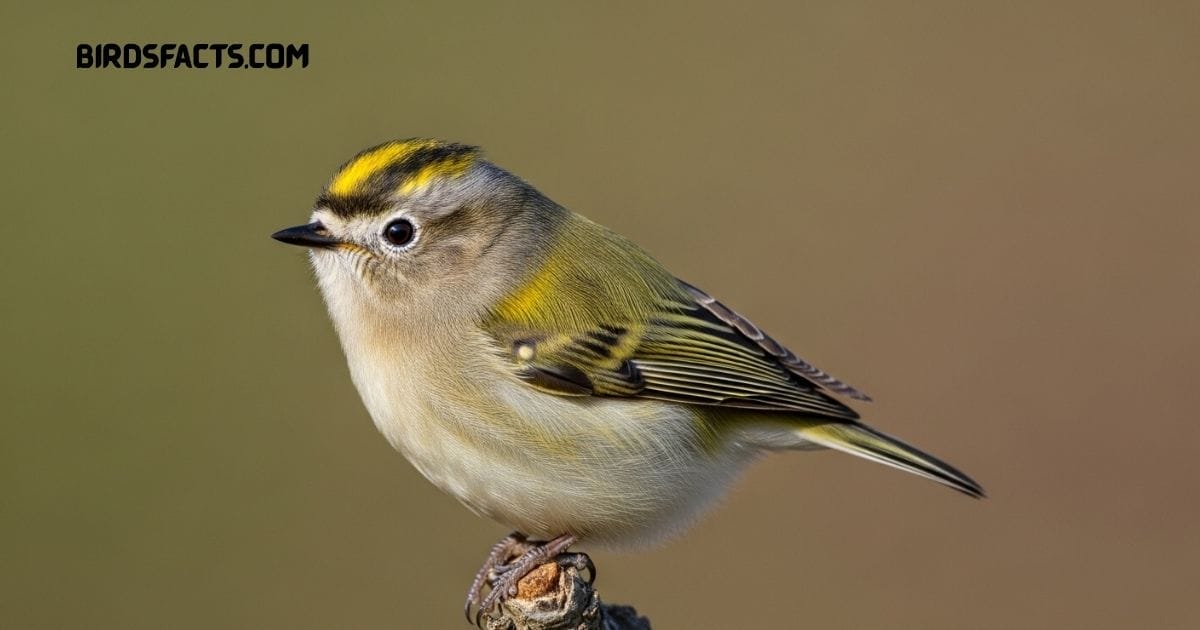
Golden-crowned Kinglet with olive-green body and bright yellow crown stripe perched on a branch
The Golden Crowned Kinglet Is Truly One Of The Smallest Birds in Michigan Weighing Only A Few Grams. This Tiny Bird Has Olive Gray Plumage With A Bold Golden Crown Stripe Bordered By Black. Despite Its Delicate Size It Is Remarkably Hardy And Often Survives Harsh Winters In The Northern Forests. Birders Often Spot Them Flitting Nervously Through Evergreens In Search Of Insects.
Their High Pitched Calls Can Be Difficult To Hear But Once You Know Them They Stand Out Clearly In Quiet Woods. Kinglets Are Restless Foragers Moving Constantly And Hanging Upside Down On Branches. Their Resilience Makes Them One Of The Most Admired Smallest Birds in Michigan Proving That Size Is Not Everything When It Comes To Survival.
| Fact | Details |
|---|---|
| Size | 3.1 – 4.3 Inches |
| Diet | Insects Spiders Larvae |
| Habitat | Coniferous Forests Winter Woodlands |
| Call | Very High Pitched “tsee Tsee” Notes |
| Fun Fact | Can Survive Sub zero Winters Despite Weighing Only 0.2 Ounces |
House Wren

House Wren with brown plumage and short tail perched on a branch
The House Wren Is A Feisty Little Bird Often Found In Michigan Backyards During Spring And Summer. Despite Its Tiny Size It Sings A Remarkably Bubbly And Complex Song That Fills The Air From Morning To Evening. Males Are Known For Building Multiple Nests Allowing Females To Choose Their Preferred Site. Their Plain Brown Appearance May Not Be Flashy But Their Bold Behavior And Cheerful Voice Make Them One Of The Smallest Birds in Michigan Worth Watching.
House Wrens Thrive In Suburban Yards Gardens And Woodland Edges Often Taking Advantage Of Birdhouses And Nesting Boxes. They Feed Primarily On Insects Making Them Natural Helpers In Pest Control. These Birds Are Fiercely Territorial Often Chasing Away Larger Species From Their Space. Watching One Of The Smallest Birds in Michigan Sing From A Fence Post Or Dart In And Out Of A Birdhouse Is A Classic Part Of Michigan Summers.
| Fact | Details |
|---|---|
| Size | 4.3 – 5.1 Inches |
| Diet | Insects Spiders |
| Habitat | Yards Gardens Woodland Edges |
| Song | Loud Bubbly And Continuous Trills |
| Fun Fact | Males Often Build Several Nests ToImpress Females |
House Finch

House Finch with brown streaked body and red head perched on a branch
The House Finch Is A Common Sight At Feeders Across Michigan Recognizable By The Males Red Streaked Head And Chest. Females Are Streaky Brown Blending In With Sparrows But Their Cheerful Songs And Flocking Behavior Help Identify Them. These Birds Were Originally Native To The Western United States But Spread Across The Country After Being Introduced In The East. Today They Are Often Seen Alongside The Smallest Birds in Michigan Bringing Color And Music To Backyard Feeders.
House Finches Thrive In Suburban Habitats And Adapt Well To Human Presence. Their Diet Is Mostly Seeds Especially Sunflower Seeds But They Also Enjoy Fruits And Buds. Unlike Some Species They Rarely Migrate So Theyre Present Year Round In Michigan. Their Musical Warbling Adds A Pleasant Soundtrack To Neighborhood Mornings And Their Friendly Nature Makes Them Charming Companions To The Smallest Birds in Michigan Throughout The Seasons.
| Fact | Details |
|---|---|
| Size | 5 – 6 Inches |
| Diet | Seeds Fruit Buds |
| Habitat | Backyards Suburbs Farms |
| Song | Sweet Warbling Notes |
| Fun Fact | Originally Native Only To The Western U.S. |
Indigo Bunting

Indigo Bunting with vibrant blue plumage perched on a branch
The Indigo Bunting Is A Stunning Summer Visitor To Michigan Known For The Males Vibrant Blue Plumage That Glows In Sunlight. Females Are Brown And Streaked Helping Them Stay Hidden While Nesting. These Birds Migrate From Central And South America Arriving In Michigan Each May. Their Cheerful Fire Fire Where Where Here Here Song Makes Them Easy To Identify Even If Hidden In Foliage.
Indigo Buntings Prefer Open Woodlands Fields And Edges Where They Perch On Shrubs Or Wires To Sing. They Feed On Seeds Berries And Insects Providing Both Beauty And Ecological Balance. Among The Smallest Birds in Michigan These Bright Blue Singers Bring Color To Every Summer Morning. Their Long Migrations Remind Us Of The Endurance And Determination That Even The Smallest Birds in Michigan Display Year After Year.
| Fact | Details |
|---|---|
| Size | 4.7 – 5.1 Inches |
| Diet | Seeds Insects Berries |
| Habitat | Fields Woodland Edges Roadsides |
| Song | Bright “fire-fire-where-where” Notes |
| Fun Fact | Males AppearBrown In ShadeBut Dazzling Blue In Sunlight |
LeConte’s Sparrows
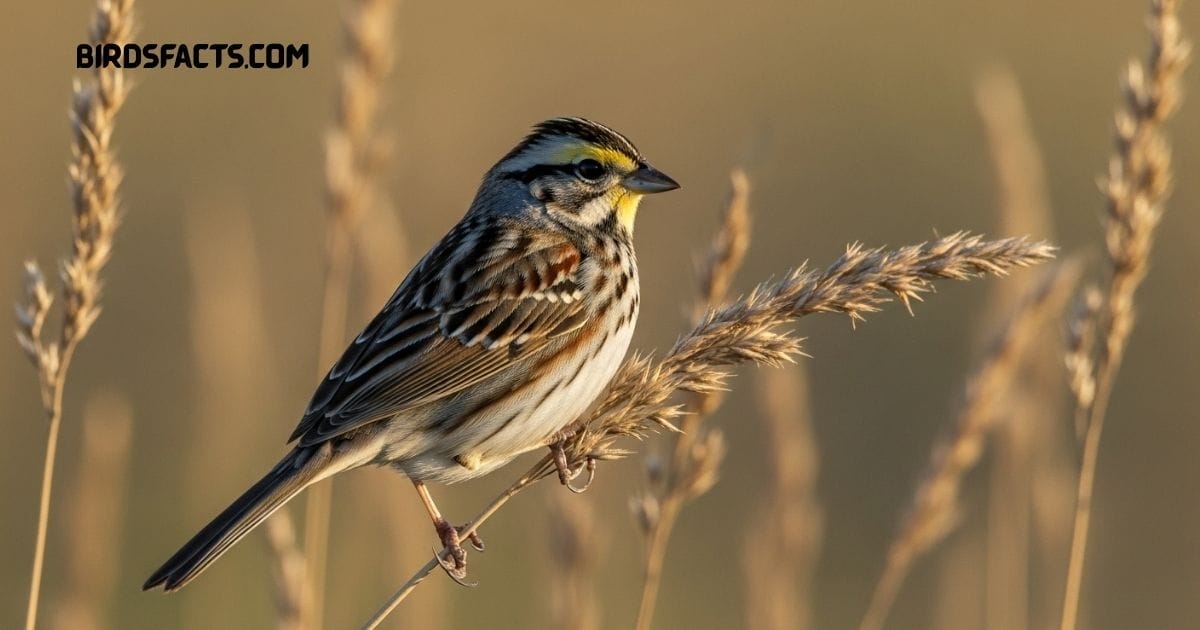
LeConte’s Sparrow with orange face and streaked brown back perched on grass stem
Lecontes Sparrow Is One Of The Most Secretive And Rare Sparrows Found In Michigan. With Its Orange Face Streaked Body And Gray Nape It Blends Almost Perfectly Into Tall Grasses And Meadows. These Tiny Birds Spend Most Of Their Time Hidden Near The Ground Darting Between Blades Of Grass Rather Than Perching In The Open. Among The Smallest Birds in Michigan Their Thin Insect Like Song Is Often The Only Clue To Their Presence.
In Michigan Lecontes Sparrows Are Usually Observed During Migration In Wet Meadows And Grasslands. Their Preference For Dense Cover Makes Them Difficult For Birdwatchers To Spot. For Those Lucky Enough To Glimpse One It Is A True Reward And A Reminder Of The Diversity Of The Smallest Birds in Michigan That Pass Quietly Through The State Each Year.
| Fact | Details |
|---|---|
| Size | 4.7 – 5.1 Inches |
| Diet | Seeds Insects |
| Habitat | Grasslands Wet meadows |
| Song | Thin Insect Like Buzz |
| Fun Fact | Known As One Of North America’s Most Secretive Sparrows |
Marsh Wren

Marsh Wren with brown plumage and bold white eyebrow stripe perched on a cattail
The Marsh Wren Is A Lively And Noisy Resident Of Michigans Wetlands. With Its Brown Plumage Bold White Eyebrow And Upright Tail It Is Easy To Spot Once You Are In The Right Habitat. Males Are Known For Their Relentless Singing Producing A Rattling Chattering Song That Can Last All Day. These Birds Are Often Heard Long Before They Are Seen As They Weave Through Cattails And Reeds.
Among The Smallest Birds in Michigan Marsh Wrens Build Elaborate Nests Often Constructing Several Dummy Nests To Protect The Real One. They Feed On Insects And Spiders Which They Pluck From Reeds And Grasses. Although Small They Defend Their Territories Fiercely Sometimes Destroying The Nests Of Rival Wrens. The Smallest Birds in Michigan Like The Marsh Wren Show That Even The Tiniest Creatures Can Fill Wetlands With Sound And Life.
| Fact | Details |
|---|---|
| Size | 3.9 – 5.5 Inches |
| Diet | Insects Spiders |
| Habitat | Marshes Wetlands Wth Cattails And Reeds |
| Song | Chattering Rattling Notes |
| Fun Fact | Known For Building Multiple “dummy nests” |
Northern Parula

Northern Parula warbler with bluish-gray back and yellow throat perched on a branch
The Northern Parula Is A Small Colorful Warbler That Brightens Michigan Woodlands During Migration. Males Feature A Bluish Gray Back Yellow Throat And A Striking Chest Band Of Orange And Black. Females Are Paler But Equally Charming With Their Soft Plumage. These Warblers Are Among The Smallest Birds in Michigan And Are Known For Their Buzzy Rising Trill That Echoes Through Forest Canopies In Spring And Fall. Spotting Them High In The Trees Can Be Challenging But Their Vibrant Colors Make The Search Worthwhile.
Northern Parulas Breed In The Northern Forests But Pass Through Much Of Michigan On Migration. They Prefer Moist Woodlands With Plenty Of Moss And Lichen Often Nesting Where Spanish Moss Is Available Further South. In Michigan They Are Admired As Fleeting But Treasured Visitors And Their Presence During Migration Waves Reminds Birders That Even The Smallest Birds in Michigan Can Bring Big Joy To The Forest.
| Fact | Details |
|---|---|
| Size | 4.3 nches |
| Diet | Insects Spiders |
| Habitat | Moist forests Migration Stopovers |
| Song | Buzzy Rising Trill Ending In a Snap |
| Fun Fact | Often Nests In Hanging Moss Further South |
Pine Siskin

Pine Siskin with streaked brown body and yellow wing edges perched on a branch
The Pine Siskin Is A Tiny Finch With Streaky Brown Plumage And Touches Of Yellow On The Wings. Though Not Flashy They Are Lively And Social Often Appearing In Large Winter Flocks At Backyard Feeders. Among The Smallest Birds in Michigan Their Buzzy Raspy Calls Help Identify Them In Flight And Their Energy Brings Life To Snow Covered Feeders.
In Michigan Pine Siskins Often Show Up During Irruption Years When Northern Populations Move South In Search Of Food. They Especially Love Nyjer Seed Feeders Where They Crowd Together With American Goldfinches. Despite Their Delicate Frame These Smallest Birds in Michigan Are Hardy Survivors Enduring Snowy Winters In Large Groups. Their Unpredictable Arrivals Make Them A Thrilling Surprise For Backyard Birdwatchers.
| Fact | Details |
|---|---|
| Size | 4.3 – 5.5 Inches |
| Diet | Seeds |
| Habitat | Coniferous Forests Feeders Mmixed Woods |
| Call | Buzzy Rising “zzzzreee” Notes |
| Fun Fact | Highly Nomadic Showing Irregular Irruptions |
Red-breasted Nuthatch

Red-breasted Nuthatch with blue-gray back and rusty-orange chest perched on a tree trunk
The Red Breasted Nuthatch Is A Small Woodland Bird With A Bold Personality. Recognizable By Its Blue Gray Back Rusty Belly And Black Eye Stripe It Often Visits Feeders In Michigan During Fall And Winter. Its Nasal Yank Yank Call Is Unmistakable And Helps Birders Locate It Among Evergreens. Among The Smallest Birds in Michigan It Stands Out For Its Habit Of Climbing Downward Headfirst Making It A Fun Bird To Observe.
In Michigan Red Breasted Nuthatches Thrive In Pine And Spruce Forests But Frequently Visit Sunflower Seed Feeders. They Are Fearless For Their Size Often Competing With Larger Birds For Food. Birders Love Them For Their Acrobatics And Energy As They Dart Up And Down Trunks In Search Of Insects. The Smallest Birds in Michigan Like The Red Breasted Nuthatch Prove That Even Tiny Species Can Bring Big Joy To Winter Birdwatching.
| Fact | Details |
|---|---|
| Size | 4.3Inches |
| Diet | Seeds Insects Conifer Seeds |
| Habitat | Coniferous Forests Backyards With Feeders |
| Call | Nasal “yank-yank” |
| Fun Fact | Climbs Trees Headfirst Unlike Most Birds |
Ruby-throated Hummingbird

uby-throated Hummingbird hovering near a flower with its bright red throat shining
The Ruby Throated Hummingbird Is Perhaps The Most Iconic Of The Smallest Birds in Michigan. Males Have Glittering Red Throats While Females Are Plain With White Underparts. Their Wings Beat Up To Fifty Times Per Second Allowing Them To Hover Gracefully As They Sip Nectar. These Birds Migrate Thousands Of Miles Each Year Traveling From Central America To Michigan And Back.
Backyard Birdwatchers Eagerly Hang Nectar Feeders To Welcome Ruby Throated Hummingbirds Each Spring. They Also Visit Gardens Rich In Tubular Flowers Like Bee Balm And Trumpet Vine. Despite Their Fragile Size They Are Fiercely Territorial Often Chasing Away Other Hummingbirds From Feeders. Watching One Hover Inches Away Is An Unforgettable Experience And A Perfect Example Of Why The Smallest Birds in Michigan Capture So Much Admiration.
| Fact | Details |
|---|---|
| Size | 3 – 3.5 Inches |
| Diet | Nectar Insects Spiders |
| Habitat | Gardens Woodlands Meadows |
| Flight | Capable Of Hovering And Flying Backwards |
| Fun Fact | Migrates Across The Gulf Of Mexico In A Single Flight |
Red Crossbill

Red Crossbill with crossed bill tips and reddish plumage perched on a pine branch
The Red Crossbill Is A Unique Finch With Crossed Bill Tips Designed To Extract Seeds From Pinecones. Males Are Typically Reddish While Females Are Yellow Green. Their Specialized Diet Ties Them Closely To Conifer Forests Where They Often Gather In Noisy Flocks. Among The Smallest Birds in Michigan They Stand Out For Their Distinctive Feeding Adaptation That Allows Them To Thrive In Harsh Forest Environments.
In Michigan Red Crossbills Are Irregular Visitors Appearing When Cone Crops Are Abundant. Their Ability To Pry Open Tough Pinecones Gives Them An Advantage In Winter Survival. Watching A Flock Descend On A Pine Tree Is Both Fascinating And Noisy As They Chatter Constantly. The Smallest Birds in Michigan Like The Red Crossbill Remind Birders Of The Remarkable Diversity Hidden Within The States Forests.
| Fact | Details |
|---|---|
| Size | 5.5 – 6.7 Inches |
| Diet | Conifer Seeds |
| Habitat | Pine and Spruce Forests |
| Call | Sharp “jip-jip” Notes |
| Fun Fact | Bill Tips Cross Over Adapted For Cone Feeding |
Song Sparrow

Song Sparrow with streaked brown plumage and central breast spot perched on a branch
The Song Sparrow Is One Of The Most Abundant And Widespread Sparrows In Michigan With Streaked Brown Plumage And A Central Breast Spot It May Look Plain At First Glance But Its Musical Song Is Unforgettable. Males Sing A Series Of Cheerful Notes That Vary By Region Making Them One Of The Most Studied Sparrows In North America. Among The Smallest Birds in Michigan These Adaptable Songsters Thrive In Backyards Marshes And Woodland Edges Bringing Music To Every Habitat.
Song Sparrows Feed On Seeds And Insects Often Foraging Close To The Ground. In Michigan They Breed Throughout The State And Remain Residents In Many Areas Year Round. Their Ability To Adapt To Almost Any Habitat Makes Them A Familiar Companion For Birdwatchers. The Smallest Birds in Michigan Like The Song Sparrow Prove That Even Modest Birds Can Fill Landscapes With Life And Sound.
| Fact | Details |
|---|---|
| Size | 4.7 – 6.7 Inches |
| Diet | Seeds Insects |
| Habitat | Fields Wetlands Suburban Yards |
| Song | Variable Sweet And Musical |
| Fun Fact | One Of The Most Regionally Diverse Sparrow Songs In North America |
Tufted Titmouse

Tufted Titmouse with gray back, white underside, and small crest perched on a branch
The Tufted Titmouse Is A Charming Little Bird Often Seen In Michigan Woodlands And Backyards With A Gray Body Large Black Eyes And A Small Crest It Has A Distinctive And Friendly Appearance. Its Whistled Peter Peter Peter Call Is Common In Mixed Forests And At Feeders. Among The Smallest Birds in Michigan Titmice Are Acrobatic Foragers Often Hanging Upside Down As They Search For Insects Or Seeds.
These Birds Are Year Round Residents In Much Of Michigan Especially In Southern Regions. They Frequently Visit Feeders Stocked With Sunflower Seeds And Peanuts Often Carrying Food Away To Eat Later. Despite Their Small Size They Are Bold And Curious Sometimes Coming Quite Close To Humans. The Smallest Birds in Michigan Like The Tufted Titmouse Bring A Sense Of Joy And Movement To Every Forest Trail And Backyard.
| Fact | Details |
|---|---|
| Size | 5.5 – 6.3 Inches |
| Diet | Seeds Nuts Insects |
| Habitat | Deciduous Forests Backyards |
| Call | Clear “peter peter peter” Whistle |
| Fun Fact | Stores Food In Hidden Spots For Later |
White-breasted Nuthatch
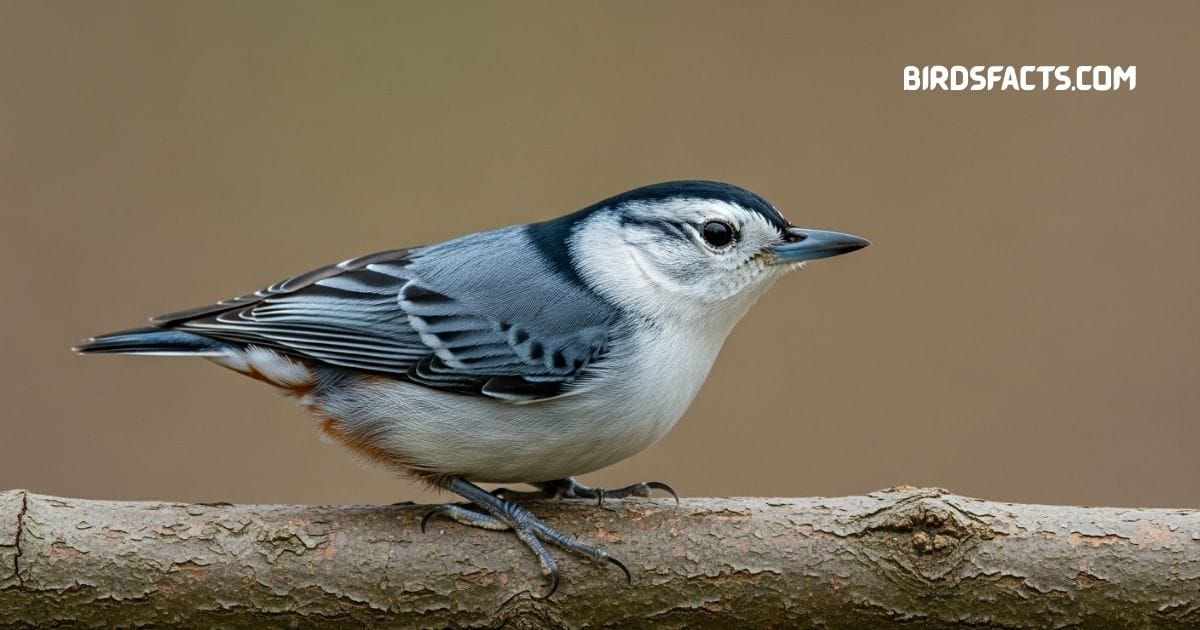
White-breasted Nuthatch with blue-gray back and white face perched on a tree trunk
The White Breasted Nuthatch Is A Bold And Energetic Little Bird Found Year Round In Michigan. With Its White Face Blue Gray Back And Black Crown It Stands Out As It Creeps Along Tree Trunks. Unlike Brown Creepers Which Move Upward Nuthatches Move Headfirst Down Tree Bark Giving Them A Unique Niche In The Woodland Ecosystem. Among The Smallest Birds in Michigan Their Nasal Yank Yank Calls Echo Through Forests And Backyards Making Them Easy To Recognize By Sound.
White Breasted Nuthatches Are Frequent Visitors To Feeders Where They Eagerly Grab Sunflower Seeds And Peanuts. They Often Carry Food Away And Cache It In Bark Crevices For Later Use. These Birds Thrive In Deciduous Forests But Adapt Well To Suburban Areas Making Them Favorites Of Backyard Birdwatchers. The Smallest Birds in Michigan Like The White Breasted Nuthatch Show That Even The Tiniest Creatures Can Display Bold Personalities And Big Energy.
| Fact | Details |
|---|---|
| Size | 5.1 Inches |
| Diet | Seeds Insects Nuts |
| Habitat | Deciduous Forests Parks Backyards |
| Call | Nasal “Yank Yank” |
| Fun Fact | Climbs Headfirst Down Tree Trunks |
White-crowned Sparrow
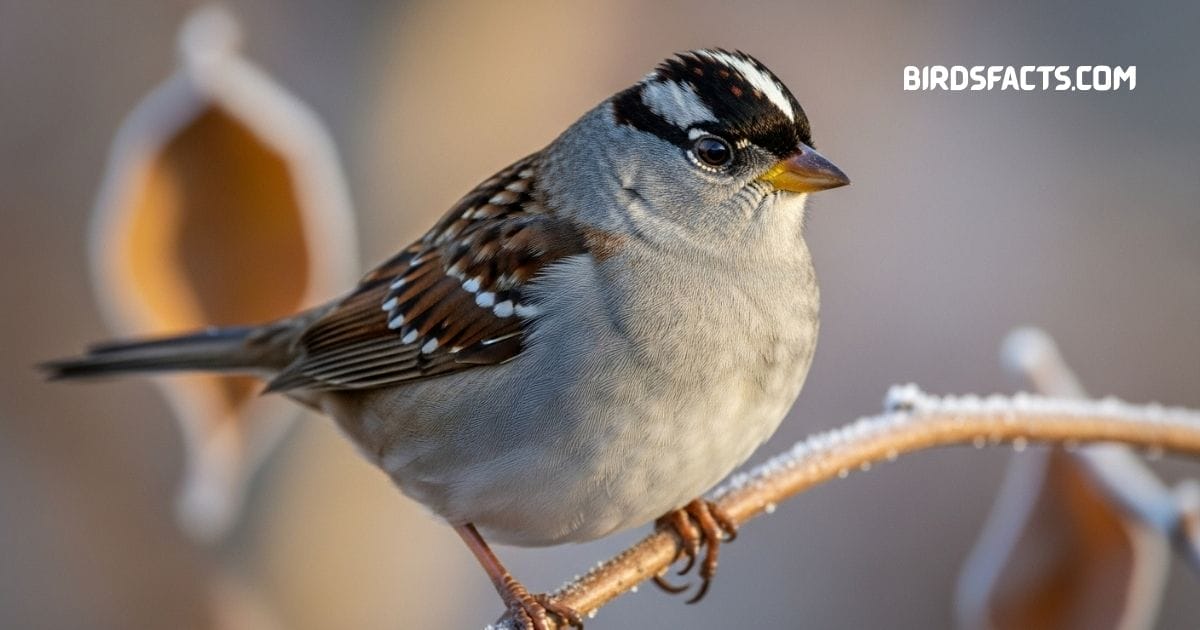
White-crowned Sparrow with bold black-and-white striped head perched on a branch
The White Crowned Sparrow Is A Striking Migratory Sparrow That Passes Through Michigan Each Spring And Fall. Adults Are Recognized By Their Bold Black And White Head Stripes While Young Birds Have Brownish Crowns. Their Clear Whistled Song Is Often Described As One Of The Prettiest Among Sparrows. Birders Look Forward To Spotting Them As They Forage Along Field Edges And Brushy Areas.
Although They Do Not Typically Breed In Michigan White Crowned Sparrows Are Common Migrants That Stop Over To Rest And Refuel. Among The Smallest Birds in Michigan They Feed Mainly On Seeds But Also Consume Insects During Migration For Extra Energy. Seeing Flocks Of These Sparrows Hopping Through Grass Or Scratching Beneath Feeders Is A Seasonal Highlight. Their Long Journeys Reflect The Endurance That Even The Smallest Birds in Michigan Possess.
| Fact | Details |
|---|---|
| Size | 5.9–6.3 Inches |
| Diet | Seeds Insects |
| Habitat | Fields Brushy Edges Migration Stopovers |
| Song | Clear Whistled Notes |
| Fun Fact | Migrates Thousands Of Miles Between Canada And The Southern U.S. |
White-throated Sparrow
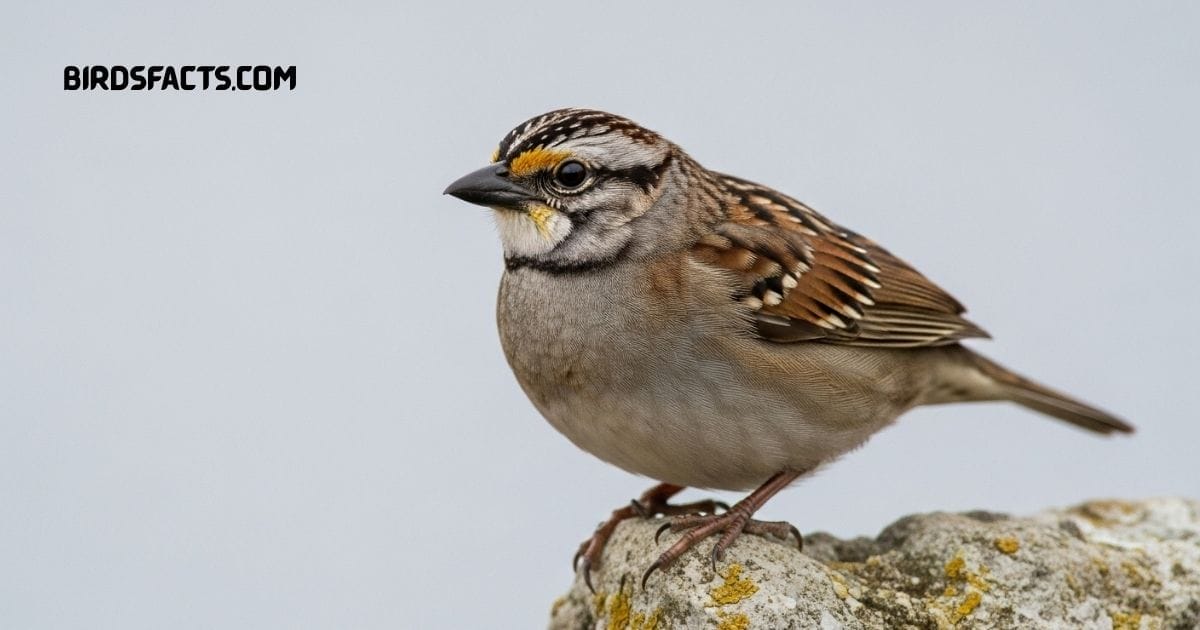
White-throated Sparrow with white throat patch and yellow lores perched on a branch
The White Throated Sparrow Is Another Migratory Sparrow That Brings Music To Michigans Forests In Spring And Fall. With Its Yellow Lores And White Throat Patch It Is Easily Distinguished From Other Sparrows. Its Famous Oh Sweet Canada Canada Song Echoes Through Woodlands During Migration. Among The Smallest Birds in Michigan Its Clear Notes Mark The Seasonal Change And Bring Joy To Every Listener.
White Throated Sparrows Forage On The Ground Scratching Through Leaf Litter For Seeds And Insects. They Sometimes Visit Backyard Feeders Especially When Offering Millet Or Sunflower Seeds. In Michigan They Are Usually Found During Migration Though Some Overwinter In Southern Parts Of The State. The Smallest Birds in Michigan Like The White Throated Sparrow Add Melody And Warmth To Even The Coolest Forest Mornings.
| Fact | Details |
|---|---|
| Size | 6.3–7.1 Inches |
| Diet | Seeds Insects Berries |
| Habitat | Forest Edges Brushy Areas Backyards |
| Song | Famous “Oh-Sweet-Canada-Canada” Whistle |
| Fun Fact | Exists In Two Color Morphs White Striped And Tan Striped |
White-eyed Vireo

White-eyed Vireo with olive-green back and bright yellow spectacles perched on a branch
The White Eyed Vireo Is A Small Energetic Bird With A Bold Song That Stands Out In Michigans Thickets And Shrubby Habitats. Its Name Comes From Its Pale White Eyes Which Contrast Sharply With Its Olive Back And Yellow Flanks. Males Sing A Series Of Sharp Scolding Phrases Often Described As Quick Give Me A Ray Check. Among The Smallest Birds in Michigan Their Active Foraging Makes Them Fun To Watch As They Dart Between Dense Branches.
In Michigan White Eyed Vireos Are Uncommon Breeders Mostly In Southern Areas With Thick Undergrowth. They Are More Often Heard Than Seen As They Prefer To Stay Hidden In Vegetation. Birders Who Track Down Their Calls Are Rewarded With A Glimpse Of One Of The More Striking Vireos In The Region. The Smallest Birds in Michigan Like The White Eyed Vireo Add Bright Energy And Character To Every Woodland Walk.
| Fact | Details |
|---|---|
| Size | 5.1 Inches |
| Diet | Insects Spiders Berries |
| Habitat | Thickets Brushy Fields Woodland Edges |
| Song | Sharp Scolding Phrases With Clear Notes |
| Fun Fact | Named For Their Pale White Eyes |
Yellow-bellied Flycatcher

Yellow-bellied Flycatcher with olive-green back and yellow underside perched on a branch
The Yellow Bellied Flycatcher Is One Of The Smallest Birds in Michigan And A Challenge To Identify. It Has A Greenish Back Yellowish Underparts And A Faint Eye Ring Giving It A Fresh And Delicate Look. Like Other Flycatchers It Hunts Insects By Sallying Out From Perches Returning Quickly To Its Spot. Its Soft Chu Wee Call Is A Key Clue For Birders Trying To Separate It From Similar Species.
These Small Migratory Birds Breed In Northern Bogs And Forests But Pass Through Michigan During Migration. They Prefer Dense Conifers And Damp Woodlands Making Them Harder To Spot Than More Open Country Flycatchers. Birders Prize Sightings Of This Species Because It Requires Careful Observation And Listening. Among The Smallest Birds in Michigan Their Secretive Nature Makes Each Encounter Feel Like A Rewarding Achievement.
| Fact | Details |
|---|---|
| Size | 5.1 Inches |
| Diet | Flying Insects |
| Habitat | Coniferous Bogs Damp Forests Migration Stopovers |
| Call | Soft “Chu-Wee” |
Yellow Warbler
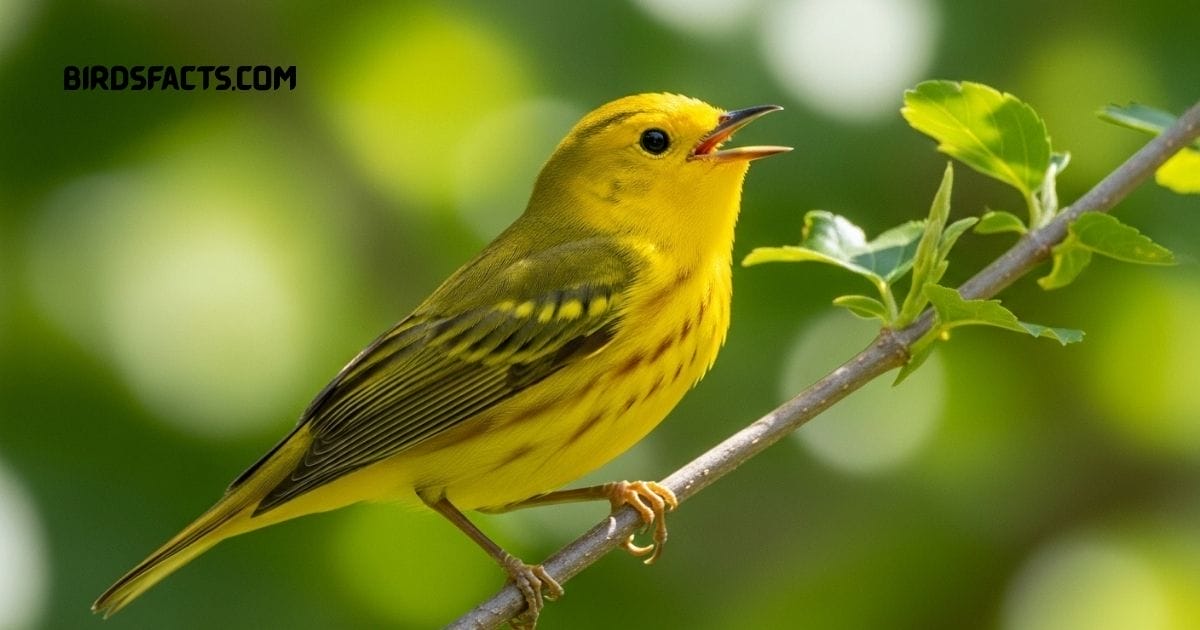
Yellow Warbler with bright yellow plumage perched on a branch
The Yellow Warbler Is One Of The Brightest And Most Cheerful Migratory Birds To Pass Through Michigan Each Spring. Males Are A Vibrant Golden Yellow With Faint Chestnut Streaks On Their Breast While Females Are Paler But Still Eye Catching. Their Sweet Sweet Sweet Im So Sweet Song Fills Wetlands Woodlands And Even Suburban Yards. Among The Smallest Birds in Michigan These Warblers Are Common But Always Delightful To Spot Because Of Their Bold Coloring And Musical Voices.
In Michigan Yellow Warblers Breed In Shrubby Thickets Willow Stands And Along Wetland Edges. They Feed Mainly On Insects Plucking Caterpillars And Beetles From Leaves. Birdwatchers Prize Them For Their Visibility As They Often Forage At Eye Level Instead Of High In The Canopy. The Smallest Birds in Michigan Like The Yellow Warbler Bring Color And Melody To Every Spring Morning Across The Great Lakes Region.
| Fact | Details |
|---|---|
| Size | 4.7 – 5.1 Inches |
| Diet | Insects Spiders Caterpillars |
| Habitat | Wetlands Shrubby Edges Suburban Yards |
| Song | “Sweet-Sweet-Sweet, I’m So Sweet” |
| Fun Fact | One Of The Most Widespread Warblers In North America |
FAQs
What Kind Of Bird Is The Smallest?
The Bee Hummingbird Of Cuba Is The World’s Smallest Bird Measuring Just About 2 Inches Long.
What Is The Most Common Bird In Michigan?
The American Robin Is Considered The Most Common And Widely Recognized Bird In Michigan.
Which Bird Is Very Small In Size?
Hummingbirds Goldfinches And Kinglets Are Among The Tiniest Birds You’ll Often See.
What Are The Small Little Birds Called?
They Are Often Called “songbirds” Or “perching Birds” Scientifically Known As Passerines.
What Bird Is Smaller Than A Wren?
Golden Crowned Kinglets And Ruby throated Humming birds Are Both Smaller Than Wrens.
Conclusion
The Smallest Birds in Michigan May Be Tiny In Size But They Leave A Giant Impression On Anyone Who Takes The Time To Watch Them. From The Bright Flashes Of A Yellow Warbler To The Delicate Hovering Of A Ruby Throated Hummingbird These Species Bring Color Music And Life To Backyards Forests And Wetlands Across The State. Each Bird Plays An Important Role In Michigans Ecosystems Controlling Insects Spreading Seeds And Showing The Strength Of Nature’s Design.
Whether You Are A Beginner Filling Your Feeder For The First Time Or An Experienced Birder Exploring Migration Hotspots Appreciating These Small Wonders Deepens Your Connection To The Natural World. Protecting Their Habitats Ensures Future Generations Can Enjoy Their Beauty And Songs. In The End The Smallest Birds in Michigan Prove That It Is Often The Little Things In Life That Bring The Greatest Joy.
Further Reading
You May Also Check Out:
- Small Black Bird with White Belly
- Birds With Orange Beaks
- Yellow Birds in Michigan
- Pink Birds
- Florida Birds with Long Beak
- Skynettool Fire Tool
Thank You For Reading!

